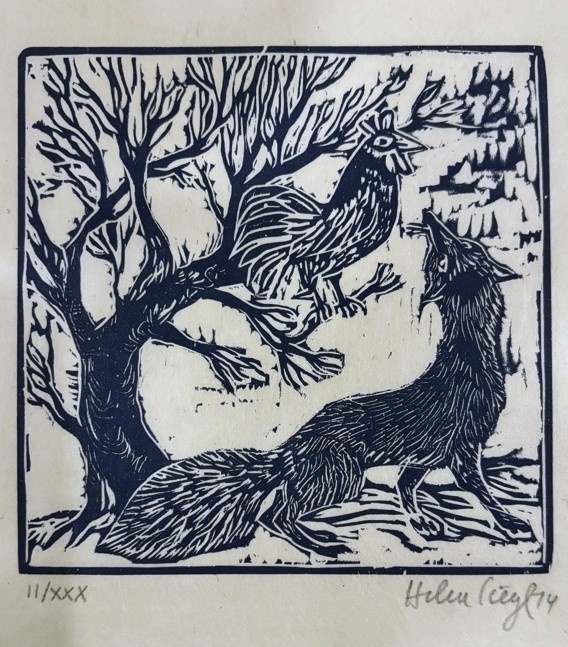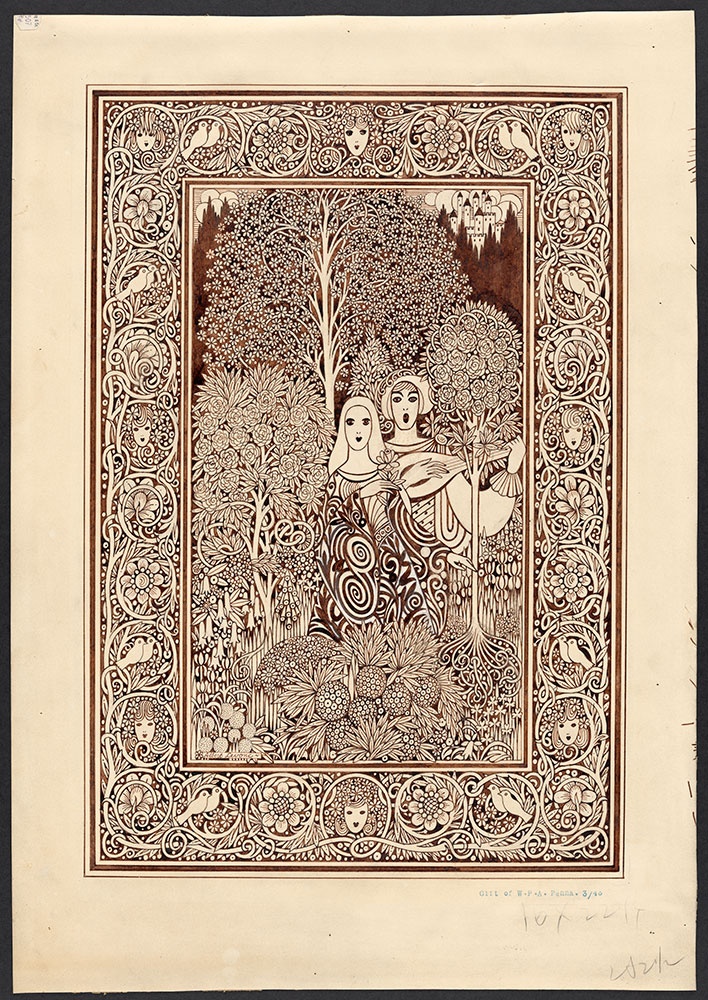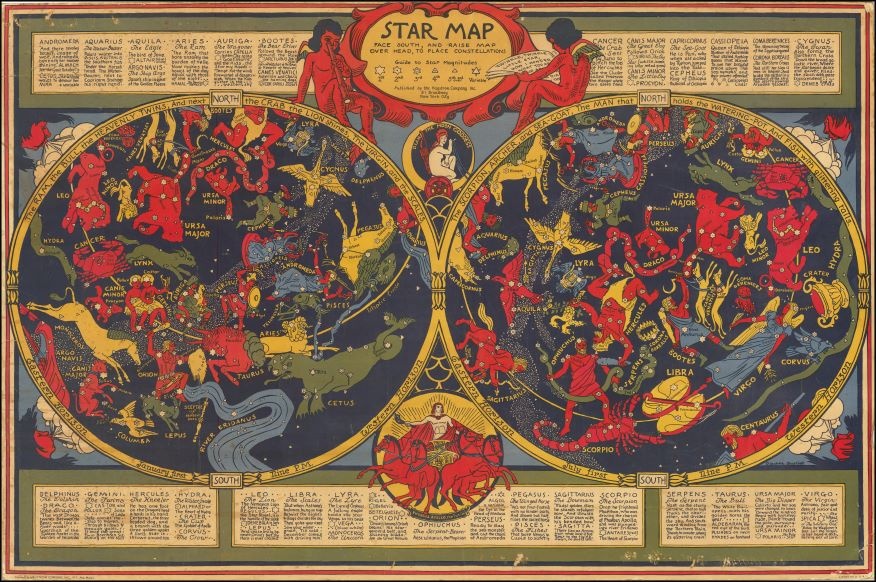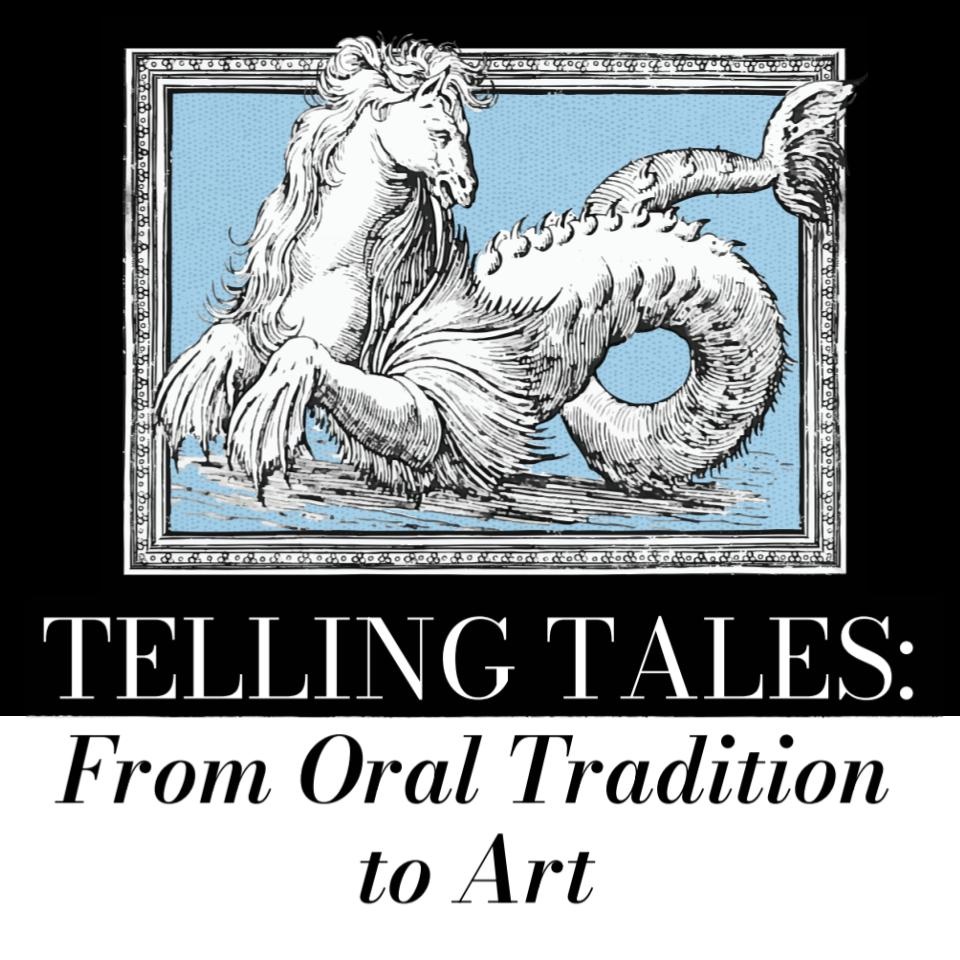The Map Collection, Print and Picture Collection, and Children's Literature Research Collection have joined together to create a new exhibition in the West Gallery on the Second Floor of Parkway Central Library. The exhibition, entitled Telling Tales: From Oral Tradition to Art focuses on four subgenres of folklore: Animal Fables, Fairytales, Legendary Creatures, and Greek Mythology.
Folklore is defined as traditional customs, tales, sayings, dances, and other art forms shared among a people. Often, we think of folklore as being from long ago, but we are surrounded by the influence of folklore today. Trick-or-treating on Halloween, Disney movies like The Little Mermaid, and popular cryptids like the "Jersey Devil" and "Jackalopes" are 20th century examples of how the influence of folklore is woven into our lives. Folklorist Lynne McNeill, in a Ted Talk from 2015, points out that contemporary folk art is created every day through social media memes as a way to connect and better understand ourselves and our culture. Folklore, which is something created by and for the common folk, is meant to identify, entertain, and inform the culture that creates it. These stories told to us as children taught us moral lessons, social control, and an appreciation of nature. They explained the world around us and even our origin as a people. But the term folklore refers to all aspects of a culture under which there are numerous sub-genres like myths, proverbs, fables, music, and even urban legends. The Telling Tales exhibition displays examples of ways in which these sub-genres of Folklore have developed over time from oral storytelling into written word and visual art.
Animal Fables
Animal fables, like Aesop’s Fables, Br’er Rabbit, and Tales of Bidpai are short stories that convey a moral lesson. In them, animals are given anthropomorphic traits like talking, walking upright, wearing clothing, and living like humans. At the same time, they tend to retain aspects of their natural character to emphasize the moral of the story. The fox and the rabbit are often portrayed as clever tricksters. The wolf is regarded as dangerous, while the sheep represents innocence. Animal fables can cross social and cultural boundaries because the characters represent stereotypes of human traits. Aesop's Fables and the Tales of Bidpai are some of the earliest recorded fables and influenced many of the fairytales that came after them.

Helen Siegl (1924-2009) A Fable of Bidpai, West Burke, Vt. Janus Press, 1974 Print and Picture Collection, Book Arts
Fairytales
Fairytales are stories that contain some form of magic and/or magical beings like fairies, fairy godmothers, trolls, dwarves, witches, and talking animals. Their oral tradition pre-dates written records and can be found in every culture throughout history. Fairytales were entertaining and often terrifying short stories that sometimes offered a moral lesson. Today, some of the most well-known fairytales were those collected by the German brothers Jacob and Wilhelm Grimm in the 19th century. The original publication of the Grimms’ Kinder- und Hausmärchen (Children and Household Tales) in 1880 was not intended for children, despite the title. It was later that the stories were edited to appeal to a younger audience. These simple tales told by common folk were more a form of entertainment, whereas the epic myths and fables were meant to educate. However, some lessons could be gleaned from them. The tale of Cinderella was an example of hidden attributes, and the reward of kindness as opposed to selfishness.

Albert Jean Levone (1895-1967), Cinderella, Pen and ink, Circa 1934
Legendary Creatures
Legendary creatures are mythical, magical creatures that are either entirely fictitious or a hybrid of existing animals. In some tales the creatures play a vital role in the plot, like the dragon in Beowulf and the Dragon; in others, the creatures will have more of a supporting role, like the Pegasus in the story of Greek hero Bellerophon. Creatures had symbolic meanings that were sometimes as simple as good versus evil, but they could also represent complex human virtues and vices. The unicorn represents purity, grace, and healing power. The pegasus represents courage, speed, and strength. Trolls represent the destructive forces of nature. Often, dragons are a symbol of evil, although in some stories they are considered wise and powerful. Dryads or tree nymphs are guardians of nature. The Sesame Street character, Mr. Snuffalupagus, is a modern fictional creature representing childlike innocence and is based on elements of existing animals like an elephant, a mammoth, or a large anteater. Like the critters in animal fables, these creatures transcend social and cultural boundaries. Dragons are one of several creatures that appear in tales all over the world, from Ancient China to Medieval England.

Jeffrey Moss (1942-1998), et al, The Sesame Street ABC Storybook, [New York] Random House: Children's Television Workshop
Mythology
The last subgenre presented by the Telling Tales exhibit is mythology, specifically Greek mythology. Mythology is defined as a collection of stories belonging to a particular culture that are presented as historical truths. Myths have existed in every civilization since ancient times. They explain the origins of humans and the world, natural phenomena, and the cycle of life. They typically include supernatural beings and events that are often linked to spiritual or religious beliefs. These stories brought a sense of order to a chaotic world. The ancient Greeks used mythology to explain the movement of the sun, moon, and stars in the sky. They were instrumental in the creation of astrology and the Zodiac, which are still influential today. Behind each Zodiac name and sign are tales derived from Greek mythology.

Elizabeth Shurtleff, 1930 Star Map
Telling Tales: From Oral Tradition to Art will be on display in the Second Floor West Gallery until January 11, 2025. The exhibition is free and accessible to the public during the Parkway Central Library’s regular hours of operation.
Check the Free Library Events Calendar to stay updated on special events related to the exhibition.
Have a question for Free Library staff? Please submit it to our Ask a Librarian page and receive a response within two business days.

